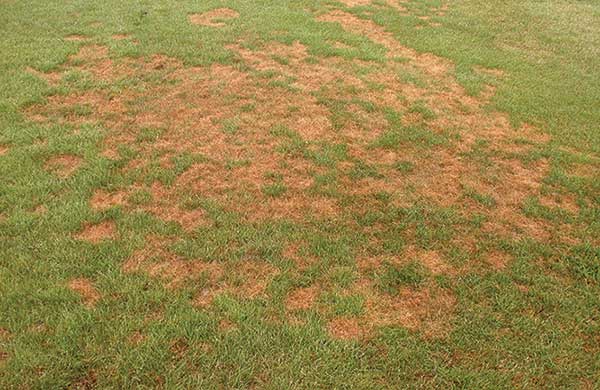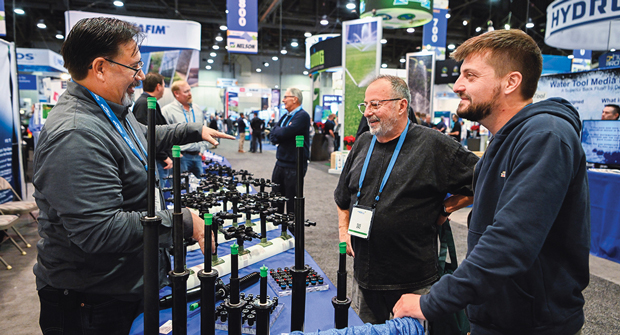Experts’ Insights: Pythium blight

Pythium blight can largely be controlled using the idealogy that an ounce of prevention equals a pound of cure. (John Kaminski, Ph.D.)
When it comes to Pythium blight, be prepared, not scared, says John Kaminski, Ph.D., professor of turfgrass science at Penn State University. Yes, Kaminski says the disease can be devastating, but there are ways to stay ahead of the disease.
While fairways, tees and greens get preventive treatments, superintendents should scout areas where Pythium blight is more likely to occur, whether that’s in the rough or areas with poor drainage.
“They still have to be paying attention and be aware of what’s going on in areas more conducive for the disease,” he says. “These areas can serve as indicators of more widespread outbreaks. These hot spots can give advanced notice and give them time to protect larger areas.”
Superintendents might get complacent, he says, since Pythium blight is not widespread or common, and they might try to stretch an application window.
As a graduate student, Kaminski says, one year, the disease occurred on generally less susceptible species, such as fine and tall fescues.
“Maybe the species isn’t as susceptible as the other highly susceptible grasses, but there is the potential for it to come in and do damage in select years,” he says.
There are key Pythium blight triggers. These include warmer nighttime temperatures, high relative humidity and extended leaf wetness of more than 12 hours.
“If you’re in the 70s at night, and an afternoon or evening rainstorm occurs, it’s a high probability that Pythium blight will show up,” he says. “You’ve got to be covered.”

Lane Tredway (Photo: Syngenta)
Syngenta
Lane Tredway, Ph.D.
Technical services manager
Pythium blight is a common problem on bermudagrass putting greens often misdiagnosed as leaf spot. On bermudagrass, it causes small brown to purple flecks or spots, which may spread in drainage or traffic patterns. Affected foliage has a greasy consistency when wet, but abundant mycelium is rarely observed. Pythium blight may also attack bermudagrass and zoysiagrass at fairway or rough height during prolonged periods of wet, cloudy weather. Areas that are poorly drained, shady or suffer from lack of air movement are likely to develop Pythium blight earlier than other areas. Monitoring areas regularly for symptoms can provide an early warning. Providing good soil drainage and air movement and avoiding overirrigation can help reduce disease pressure. However, when temperatures and moisture levels are highly conducive, preventive fungicide applications are needed. A Pythium prevention foundation is a phosphonate fungicide like Appear II fungicide tank mixed with an Action brand fungicide on a 14-day interval.

Ian Rodriguez (Photo: Quali-Pro)
Quali-Pro
Ian Rodriguez, Ph.D.
Technical services manager
Early signs of Pythium blight are darkened leaves that may feel greasy to the touch. These leaves dry to form brown spots that can grow rapidly, even spreading in a directional pattern if moved by mowing or water. With continued heat and humidity, the diseased areas can develop a white fluffy mycelium. It can be an issue on bermudagrass in fall through spring, but it is typically a more serious issue in cool-season turf during warmer months. Pythium species are water molds and are associated with heavy rain or irrigation events followed by warm, humid days. When Pythium-favoring weather conditions are in the forecast, preventive fungicide applications are recommended. If an extended program is required, be sure to rotate between FRAC fungicide codes to lower the risk of selecting for resistance. Minimizing leaf wetness by watering in the morning, improving drainage and controlling thatch can also help.

Brian Aynardi (Photo: PBI Gordon)
PBI-Gordon Corp.
Brian Aynardi, Ph.D.
Northeast research scientist
In cool-season turfgrass stands, Pythium blight requires greater than 90 percent relative humidity for 14 consecutive hours, daytime temperatures in excess of 85 degrees F and temperatures higher than 65 degrees F at night to develop. Pythium blight is seen on warm-season turfgrass under less restrictive environmental parameters, especially on bermudagrass greens. Symptoms start as dark-colored, water-soaked pockets or spots on turf that have a “greasy” feel. A smoke ring may also be present at the edge of affected turf, which becomes bronze or tan in color. Cottony aerial mycelium is a characteristic sign, which is often followed by rapid death (blighting) of turf. Monitoring for conducive environmental conditions is key to deploying effective preventive fungicidal measures. Promote air movement by pruning shrubs and trees, avoid overfertilization and select fungicides that include any of the following active ingredients: cyazofamid, azoxystrobin, propamocarb and mefenoxam. Additionally, preventive applications of phosphites aid in control.

Ken Hutto (Photo: FMC Specialty Solutions)
FMC Specialty Solutions
Ken Hutto, Ph.D.
Product development manager, herbicides/fungicides
For cool-season turfgrass, Pythium blight becomes a problem when environmental conditions are hot and humid (daytime highs in low to mid-90s and nighttime temps in mid-80s). This disease produces white, cottonlike mycelium, especially in poorly drained areas with little air circulation. Damage initially looks like water-soaked or greasy spots. Blighted, tan-colored turfgrass occurs in small circular patterns, which can follow drainage patterns. Improve air circulation by thinning trees or installing fans around troublesome greens. Avoid irrigating in late afternoon or early evening and avoid applying high amounts of nitrogen during hot, humid conditions. The most susceptible turfgrass to Pythium blight are perennial ryegrass, annual bluegrass, tall fescue and creeping bentgrass. In certain situations, ultradwarf bermudagrass can be susceptible. Fairways or greens cut into areas with low air circulation and poor drainage can be damaged more often than areas with good air circulation.










